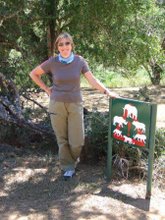Aswan's Cleopatra Hotel wasted no time in selling us a trip back to Abu Simbel, last seen from the decks of the Sudan-Egypt ferry. It had looked great from the lake, and we were sure it would be even better from land. And it was. The only thing is that the Egyptians are very protective of their tourists (with good reason, there was a massacre at Luxor round 10 years ago, and there have been bombs on the Sinai Peninsular also, more recently), and by road in the south we must all travel in convoy. For some strange reason, this meant to visit Abu Simbel from Aswan we had to leave at 3.30am. But it was worth it. The temples are fantastic, both inside and out. Because these were our first Egyptian temples I hadn't known what to expect; the beautiful heiroglyphs, the statues, the columns, the rooms and corridors were all a marvellous surprise.
Next up was the famed city of Luxor. We did this as an organised minibus trip also, but left at the more satisfactory hour of 7.30. The first stop was the temple of Kom Ombo, built on a curve of the Nile, a very pretty spot indeed only slightly marred by the dozen or so tourist cruisers that were moored there. Our little minibus was filled by people who'd travelled from Aswan to Kom Ombo on a felucca. Unfortunately they were too late to visit the temple - the convoy has set times and is not at all flexible on this point. I felt a bit sorry for them, to come all this way and be unable to see something because their felucca captain had slept in seemed quite harsh.
The convoy rolled on to Edfu. This temple was really remarkable - it was huge, so many rooms and rooms off rooms, corridors, stairways and really beautiful carved granite falcons guarding the entrances.
So, to Luxor. We stayed at the Sunset Hotel - again a 3 star hotel (we were getting soft). After a quick lunch break, the tour continued. First the Karnak Temple - again incredibly impressive; lots of columns (134 I think), and a temple within a temple. Nice to have a guide at this one, who also took us around Luxor Temple. I liked this one a lot. It was a bit smaller so easier to get my head around. It was only unearthed after having a mosque built above it, which is still there, and it had also been a refuge for Christians fleeing Roman persecution, so included some faded frescoes on one wall. Alexander the Great had also built himself a temple here, demolishing some even older columns to do so. Because this temple is in the middle of the city, we got to see it in the evening, all lit up. Very picturesque, specially as it's virtually on the banks of the Nile.
That was certainly enough ruins for one day, we were in serious danger of overloading, and had to keep ourselves fresh for the next day.
Our guide came to dinner with us, and somewhat sadly took us to a sort of McPizza place. The food was OK, but hardly what we have come to Egypt for. However, in his favour, we were upstairs and had a grandstand view of a wedding. The bride emerged from the hairdressers across the road, dressed in a classic western white wedding dress, and was greeted by her groom, and a paid band of trumpeters and drummers who blocked the street for 15 minutes while they loudly played their instruments and the whole event was videoed for posterity. There were a few guests, but apprently most of them were at the reception waiting for the bride and family to arrive. It was a raucous business, and both bride and groom were looking a bit shell shocked.
The Valley of the Kings was our first stop the next morning. It was in an incredibly harsh desert, and housed tombs of many of Egypt's later pharoahs. The tombs were all built on the west bank, where the sun sets; with the east bank, where the sun rises, used for temples. We learned that the Egyptians changed from building pyramids as tombs (which were too easy for tomb robbers to find), to burying their illustrious dead in holes (where unfortunately the jackals would dig them up - which apparently led to the cult of Anubis, the jackal-headed god), to finally using underground tombs deep in the desert. Didn't really work as the tomb robbers still found most of them, with the exception of King Tutankhamen's which was discovered by Howard Carter (and I suspect some local assistance) in 1922. Howard's house was still on the hill overlooking the valley, most of the booty was in the Egyptian museum in Cairo (which has got to be better than being in some European museum) and the tomb itself cost an additional fee to see. Ah well. Our ticket gave us entry to three of the four tombs able to be visited. It seemed that a pharoah's tomb was begun as soon as he became king - meaning King Tut's was very small as he died very young, and Ramses II's was very large as he reigned for 67 years (but his tomb was closed for restoration). We did get to see the tomb of Ramses III, very impressive, and because it was enclosed (unlike the temples we'd already seen) the paint on the walls and heiroglyphs was still visible and vibrant. It must have been an incredible sight to see them new. It was really hot here, but luckily we didn't have to walk far. The site thoughtfully provided a dinky wee train for us to use to go from the car park to the tomb entrances. Kind of funny, but also handy.
There had to be a shopping stop on a tour like this, and it was at the alabaster factory. In amongst all the tat, there were some nice pieces, and I ended up buying a hand-finished vase - but forgot to ask whether it was waterproof or not.
We stopped briefly at the funeray temple of Queen Hapshupet, but didn't go in. Her stepson, who she had usurped as leader, took umbrage after her death and destroyed the insides of many of her edifices. The Valley of the Queens was the last official visit. Pretty small compared to the kings, but still very impressive. I think by this stage we were a bit templed out, and happy to get back to town and some air conditioning.
Our next destination was Africa's largest city and capital of the Arab world, Cairo. Our arrival here would signal the successful end to our Cape to Cairo overland trip so some sadness mixed in with the satisfaction of having made such a journey.
But first we had to get there. We read there was a bus at 8.30am. The bus station in Luxor is quite a way out of town, so we took a taxi. It was the most suspiciously quiet bus station I'd seen in Africa. Only a few locals lying around, and two Japanese tourists waiting to go to Hurghada - a town on the coast. We checked at the ticket window. Yes there was a bus to Cairo at 8.30, and tickets could be purchased once it arrived. We settled down to wait. Sure enough, a bus arrived, the Japanese guys leapt up, and the ticket office confirmed it was the Hurghada bus, and the Cairo one left at 7 in the evening. Back in a taxi and to the railway station. There is a weird rule in Egypt that tourists can't buy train tickets unless they are sleeping class or first class. The next Cairo train was at 9.15, and there were no first class tickets left. We decided to get on a second class carriage and buy tickets directly from the conductor. The train was on time, and very comfortable. Nice seats, air conditioning, and we bought tickets without any problems. The 10 hour trip passed very pleasantly. Our fellow travellers shared their food, and chatted as much as they could. Cairo station seemed quite orderly and we managed to get a taxi for probably only twice as much as we should have paid.
The Richmond Hotel is a real classic. In a beautiful old building, and on the fifth floor, we were told it had been a hotel for 130 years. The lift certainly felt like it was that old - a six sided wooden walled and gated affair, it slowly and reliably creaked its way up and down all day. Our room was quite lovely too - very large with a high ceiling and a balcony. No air conditioning and a shared bathroom - probably no stars at all this time! But we did get bread, jam and coffee for breakfast and the management was very friendly and helpful.
I was prepared for a crazy town, but Cairo seemed much more developed, organised and orderly than I was expecting it to be, and the lovely architecture was also a pleasant surprise. There's quite a bit of French influence apparent in Egypt, I guess from when the French & the Brits ran things together here, and Cairo is full of really quite beautiful French-influenced buildings that you can still appreciate from the street - one of which is our hotel. There's also a colonial British presence, which we ferreted out one evening at the Windsor Hotel - former home of the British Service Club in Cairo and still a quaint old bar serving good food and cold delicious beer.
The final cultural outing for now was a visit to the Egyptian Museum. I had heard great things about this place from friends and from Paul Theroux. It was a bit more shambolic and less well catalogued than I'd expected, but still a wonderful place to wander around for a few hours. Highlights for me were, of course, the fabulous treasures from King Tut's tomb, and the many mummies and sarcophogi. But it was very, very hot. Next time, I'll visit late in the day when there are fewer people and it's cooler. The Nile Hilton over the road beckoned afterwards.




No comments:
Post a Comment